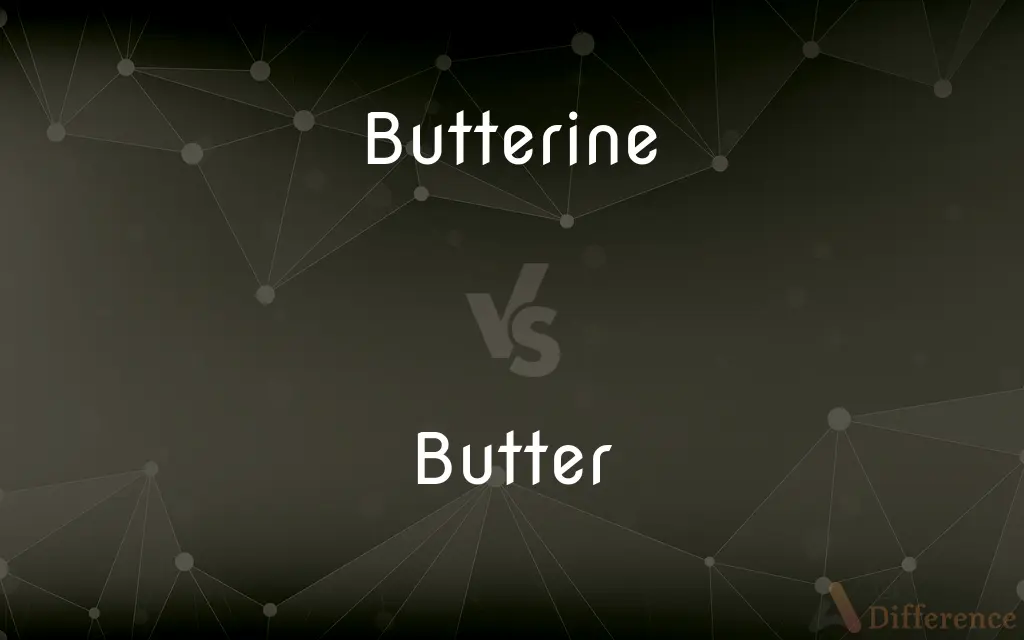Butterine vs. Butter — What's the Difference?
By Tayyaba Rehman & Urooj Arif — Updated on April 4, 2024
Butterine is a margarine type, often made from vegetable oils, while butter is a dairy product made from churned cream.

Difference Between Butterine and Butter
Table of Contents
ADVERTISEMENT
Key Differences
Butterine, often referred to as margarine, is primarily made from vegetable oils and is designed to be a cheaper alternative to butter. On the other hand, butter is a traditional dairy product made by churning cream, separating the fat from the liquid (buttermilk), and is known for its rich flavor and high content of saturated fats.
While butterine is engineered to mimic the taste and texture of butter, it often contains additives such as emulsifiers and colorants to achieve this similarity. Butter, in contrast, is a natural product with a simple manufacturing process, and its flavor can vary subtly depending on the feed and breed of the cows.
Butter is valued in cooking and baking for its flavor and the ability to contribute to the texture of various dishes, such as flakiness in pastries. Butterine, although it can be used in similar culinary applications, may not provide the same depth of flavor or texture due to its different fat composition.
Health considerations also differ significantly between the two. Butter is high in saturated fats, which can be a concern for heart health, while butterine is often high in unsaturated fats and sometimes trans fats, depending on the manufacturing process, which have their own health implications.
Butterine's development was partly due to economic reasons, providing a cost-effective and stable alternative to butter. This aspect makes it a popular choice in various contexts, including food service and with individuals looking to reduce animal fats in their diet. Meanwhile, butter remains a premium product, prized for its natural qualities and culinary superiority.
ADVERTISEMENT
Comparison Chart
Base Ingredient
Mainly vegetable oils
Cream from milk
Production Purpose
To offer a cheaper, plant-based alternative to butter
To create a rich, flavorful dairy product
Taste & Texture
Designed to mimic butter, may contain additives
Natural, rich flavor; texture can vary with cream
Culinary Uses
Versatile but might not offer the same flavor depth
Preferred for flavor and texture in baking and cooking
Health Aspects
High in unsaturated fats, sometimes trans fats
High in saturated fats, contains cholesterol
Compare with Definitions
Butterine
A type of margarine made mainly from vegetable oils.
Butterine is often used as a vegan substitute for butter.
Butter
Prized in baking for contributing to flakiness in pastries.
The secret to flaky croissants is using high-quality butter.
Butterine
Designed to be a cheaper alternative to dairy butter.
Due to its lower cost, butterine is popular in large-scale food preparation.
Butter
Contains high levels of saturated fats.
Nutritionists sometimes caution against excessive butter consumption due to its fat content.
Butterine
Can be used in cooking and baking.
Butterine can be used in recipes as a substitute for butter, though the results may vary.
Butter
A dairy product made by churning cream.
High-quality butter is often sought after for gourmet cooking.
Butterine
Contains additives for flavor and color.
Some types of butterine are colored to look more like real butter.
Butter
Known for its rich flavor and creamy texture.
The butter added a luxurious richness to the sauce.
Butterine
Often marketed as a healthier option.
Butterine brands may highlight their lower saturated fat content compared to butter.
Butter
Can vary in flavor based on the cows' diet.
Grass-fed cows produce butter that is richer in flavor and nutrients.
Butterine
An imitation butter prepared from animal fat with other ingredients.
Butter
Butter is a dairy product made from the fat and protein components of churned cream. It is a semi-solid emulsion at room temperature, consisting of approximately 80% butterfat.
Butterine
A substance prepared from animal fat with some other ingredients intermixed, as an imitation of butter.
The manufacturers ship large quantities of oleomargarine to England, Holland, and other countries, to be manufactured into butter, which is sold as butterine or suine.
Butter
A pale yellow edible fatty substance made by churning cream and used as a spread or in cooking.
Butter
Spread (something) with butter
Lily buttered a slice of toast
Butter
A soft yellowish or whitish emulsion of butterfat, water, air, and sometimes salt, churned from milk or cream and processed for use in cooking and as a food.
Butter
A spread made from fruit, nuts, or other foods
Plum butter.
Cashew butter.
Butter
A vegetable fat having a nearly solid consistency at ordinary temperatures.
Butter
Flattery.
Butter
To put butter on or in.
Butter
A soft, fatty foodstuff made by churning the cream of milk (generally cow's milk).
Butter
Any of various foodstuffs made from other foods or oils, similar in consistency to, eaten like or intended as a substitute for butter (preceded by the name of the food used to make it).
Peanut butter
Soy butter
Chocolate butter
Butter
Any of various substances made from other (especially plant-based) oils or fats, used in moisturizers, cosmetics, etc.
Butter
Any specific soft substance.
Butter of antimony; butter of arsenic
Butter
A smooth plane landing.
Butter
Someone who butts, or who butts in.
Butter
(transitive) To spread butter on.
Butter the toast.
Butter
To move one's weight backwards or forwards onto the tips or tails of one's skis or snowboard so only the tip or tail is in contact with the snow. Similar to applying butter to bread with then end of a butterknife.
Butter
To spin on skis or a snowboard using only the tips or tails being in contact with the snow
Butter
To increase (stakes) at every throw of dice, or every game.
Butter
Very smooth, very soft
That landing was total butter!
Butter
An oily, unctuous substance obtained from cream or milk by churning.
Butter
Any substance resembling butter in degree of consistence, or other qualities, especially, in old chemistry, the chlorides, as butter of antimony, sesquichloride of antimony; also, certain concrete fat oils remaining nearly solid at ordinary temperatures, as butter of cacao, vegetable butter, shea butter.
Butter
One who, or that which, butts.
Butter
To cover or spread with butter.
I know what's what. I know on which sideMy bread is buttered.
Butter
To increase, as stakes, at every throw or every game.
Butter
An edible emulsion of fat globules made by churning milk or cream; for cooking and table use
Butter
A fighter who strikes the opponent with his head
Butter
Spread butter on;
Butter bread
Common Curiosities
What are the health implications of consuming butter?
Butter is high in saturated fats, which can be a concern for heart health if consumed in large amounts.
What is butterine?
Butterine is a type of margarine, primarily made from vegetable oils, and is designed to be a butter substitute.
What are trans fats, and are they present in butterine?
Trans fats are a type of unsaturated fat that can be harmful to heart health. Some butterines may contain trans fats, depending on how they are processed.
Can butterine be used in place of butter in recipes?
Yes, butterine can be used as a substitute for butter in many recipes, though it may alter the flavor and texture slightly.
Is butterine healthier than butter?
Butterine is often lower in saturated fats than butter, but its health impact can vary depending on the presence of trans fats and other additives.
Are there any cooking applications where butter cannot be replaced by butterine?
While butterine can substitute for butter in many cases, certain recipes, especially those where butter's unique flavor and texture are crucial, may not achieve the same results with butterine.
How is butter made?
Butter is made by churning cream, separating the fat from the liquid, to create a rich and flavorful dairy product.
Does the taste of butter vary?
Yes, the taste of butter can vary based on the cows' diet and the production process, with grass-fed cows typically producing richer-flavored butter.
Can butterine be considered a vegan product?
Yes, most butterines, being made from vegetable oils, are suitable for a vegan diet, unlike butter, which is an animal product.
Why might someone choose butterine over butter?
Individuals may choose butterine over butter for economic reasons, dietary restrictions, or to reduce saturated fat intake.
Share Your Discovery

Previous Comparison
Cougar vs. Panther
Next Comparison
Intuition vs. PremonitionAuthor Spotlight
Written by
Tayyaba RehmanTayyaba Rehman is a distinguished writer, currently serving as a primary contributor to askdifference.com. As a researcher in semantics and etymology, Tayyaba's passion for the complexity of languages and their distinctions has found a perfect home on the platform. Tayyaba delves into the intricacies of language, distinguishing between commonly confused words and phrases, thereby providing clarity for readers worldwide.
Co-written by
Urooj ArifUrooj is a skilled content writer at Ask Difference, known for her exceptional ability to simplify complex topics into engaging and informative content. With a passion for research and a flair for clear, concise writing, she consistently delivers articles that resonate with our diverse audience.














































